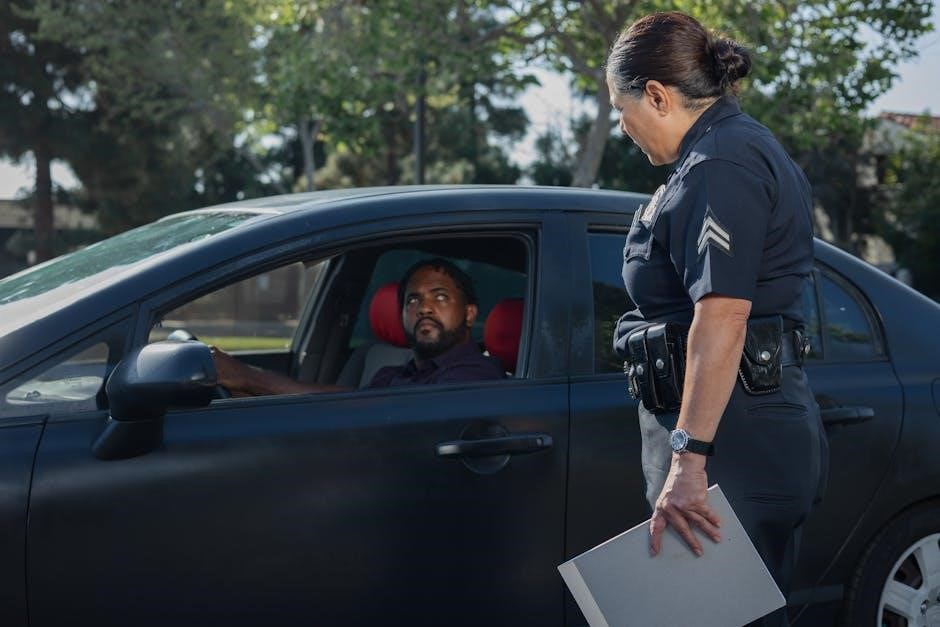The Body Control Module (BCM) is a central electronic component in modern vehicles, managing various body-related functions like power windows, lighting, and door locks․ Unlike the Powertrain Control Module (PCM), which focuses on engine operations, the BCM oversees electrical systems within the vehicle’s body, ensuring seamless functionality and integration of diverse systems for enhanced performance and safety․
1․1 Definition and Role in Automotive Systems
The Body Control Module (BCM) is a central electronic component acting as the “brain” of a vehicle’s electrical systems․ It manages and coordinates functions such as interior/exterior lighting, power windows, windshield wipers, and door locks․ By integrating these systems, the BCM streamlines operations, reducing the need for complex wiring and enhancing reliability․ Its role is crucial for ensuring efficient communication and control among various vehicle components, making it indispensable for modern automotive functionality․
1․2 Evolution of BCM in Modern Vehicles
The Body Control Module (BCM) has evolved significantly over time, transitioning from basic control of lighting and windows to managing complex systems․ Technological advancements in microprocessors and software have enabled integration of multiple functions, reducing wiring complexity․ Modern BCMs now support communication protocols for seamless interaction with other modules, enhancing vehicle functionality and efficiency․
Key Functions of the Body Control Module
The BCM manages power windows, interior/exterior lighting, windshield wipers, and door locks․ It ensures efficient operation of these systems, enhancing driver convenience and vehicle safety․
2․1 Power Window Control
The BCM regulates power window operations, ensuring smooth opening and closing functions․ It monitors window switches, motor feedback, and safety features like auto-reverse to prevent accidents․ This module also manages window lockouts and one-touch operations, enhancing convenience and safety for drivers and passengers․
2․2 Interior and Exterior Lighting Management
The BCM manages both interior and exterior lighting systems, ensuring proper operation of headlights, taillights, and cabin lights․ It controls automatic lighting functions, such as turning lights on/off based on ambient light conditions, and synchronizes lighting operations for consistency․ This module also handles dimming controls and fault detection, enhancing driver convenience and safety while maintaining energy efficiency․
2․3 Windshield Wiper and Washer System Control
The BCM regulates the windshield wiper and washer systems, enabling automatic and manual control․ It adjusts wiper speed based on rain intensity and monitors washer fluid levels․ If issues arise, the BCM activates failsafe modes to ensure visibility, enhancing safety and driver convenience․ This integration simplifies wiring and optimizes system performance, making it a crucial component for reliable operation in various driving conditions․ The BCM ensures seamless functionality of these essential systems․
2;4 Door Lock and Unlock Mechanisms
The BCM manages the door lock and unlock mechanisms, enabling automatic and remote operation․ It integrates with keyless entry systems, ensuring secure and convenient access․ The module also monitors door status, activating alarms for unauthorized access․ If issues occur, such as erratic locking behavior, the BCM can trigger diagnostic alerts․ Proper BCM function is essential for maintaining vehicle security and driver convenience․
The BCM simplifies door control by centralizing commands, reducing wiring complexity․ It ensures synchronized operation of all doors, enhancing reliability․ If malfunctions arise, reprogramming or replacing the BCM may be necessary to restore functionality․ This ensures seamless operation of door mechanisms, maintaining safety and convenience for drivers and passengers alike․

Importance of the BCM in Vehicle Operation
The BCM is crucial for integrating and controlling various vehicle systems, enhancing reliability, safety, and driver convenience․ It ensures seamless operation of electrical components, optimizing overall performance․
3․1 Enhancing Vehicle Reliability and Efficiency
The BCM enhances vehicle reliability by centralizing control of electrical systems, reducing wiring complexity and potential faults․ It optimizes efficiency through precise power management, ensuring consistent performance across all functions․ This integration minimizes the risk of system failures, providing a more dependable driving experience․ By streamlining operations, the BCM plays a vital role in maintaining overall vehicle reliability and operational efficiency․
3․2 Improving Safety and Driver Convenience
The BCM enhances safety by managing critical systems like lighting, wipers, and door locks, reducing accident risks and improving visibility․ It also offers convenience through automated features, minimizing driver distractions․ By integrating these functions, the BCM ensures a safer, more comfortable driving experience while maintaining reliable operation of essential vehicle systems․
3․3 Integration with Other Vehicle Control Modules
The BCM seamlessly integrates with other control modules, such as the Powertrain Control Module (PCM) and Electronic Control Units (ECUs), to ensure coordinated operation of vehicle systems․ This integration allows for efficient data exchange, enabling features like synchronized lighting, security systems, and adaptive responses to driver inputs․ Such interconnectedness enhances overall vehicle functionality, reliability, and performance․
Common Symptoms of a Failing BCM
A failing BCM can cause erratic behavior in vehicle systems, such as malfunctioning power windows, unresponsive door locks, and inconsistent lighting․ These issues often indicate a problem with the module․
4․1 Malfunctioning Power Windows
Malfunctioning power windows are a common symptom of a failing BCM․ Drivers may experience windows that stop working entirely, operate sporadically, or fail to respond to controls․ This issue arises when the BCM struggles to send proper signals, disrupting communication between switches and motors․ In some cases, windows might reverse direction unexpectedly or stop mid-operation, posing a safety hazard․ Such malfunctions often prompt further investigation into the BCM’s condition․
4․2 Erratic or Non-Responsive Lighting Systems
Erratic or non-responsive lighting systems are another indicator of a failing BCM․ Drivers may notice interior or exterior lights flickering, dimming, or failing to activate altogether․ In some cases, lights may turn on unexpectedly without input․ This occurs when the BCM struggles to regulate power distribution or communicate with lighting components․ Such irregularities can be frustrating and pose safety risks, especially for nighttime driving or low-visibility conditions, making prompt diagnosis essential․
4․3 Unexplained Door Lock and Unlock Issues
Unexplained door lock and unlock issues are a common symptom of a failing BCM․ Drivers may experience doors locking or unlocking intermittently, without any input from the key fob or door switches․ In some cases, the locks may become completely unresponsive or stuck in a locked or unlocked position․ This erratic behavior can be frustrating and pose safety concerns, as it may prevent proper vehicle access or compromise security․ Such issues often indicate a problem with the BCM’s ability to regulate door lock actuators effectively․

Diagnostic and Testing Procedures
Diagnostics involve using tools like multimeters and OBD2 scanners to identify BCM faults․ A systematic approach ensures accurate testing of electrical circuits and communication systems, guiding repairs effectively․
5․1 Using a Multimeter for BCM Testing
A multimeter is essential for diagnosing BCM issues by measuring voltage, current, and resistance․ It helps verify power supply to the BCM, ensuring proper voltage levels at connectors․ Testing ground connections is crucial to identify open or short circuits․ A multimeter can detect faulty signals or corrupted data lines, aiding in isolating electrical faults․ This step-by-step approach ensures accurate troubleshooting, verifying if the BCM or related components are malfunctioning, and guiding necessary repairs effectively․
5․2 OBD2 Scanner Diagnostics
An OBD2 scanner is a valuable tool for diagnosing BCM issues by retrieving trouble codes and monitoring real-time data․ It identifies malfunctions in the BCM by scanning for specific fault codes related to body systems․ The scanner can also perform system tests, such as checking the operation of power windows or door locks․ While it provides critical insights, it may not cover all BCM functions, requiring additional tools like a multimeter for comprehensive diagnostics․
5․3 Step-by-Step BCM Testing Guide
A systematic approach is essential for testing the BCM․ Start by locating the BCM, typically found under the dashboard or in the glove compartment․ Use a multimeter to check power and ground connections, ensuring they meet specifications․ Next, scan for fault codes using an OBD2 scanner to identify specific issues․ Finally, test individual systems like power windows or door locks to isolate faults; This methodical process helps pinpoint failures and guides effective repairs, ensuring all functions are restored to optimal operation․

Repair and Replacement of the BCM
BCM replacement involves costs of $200-$600 for parts, plus $100-$500 for labor and programming․ Used modules may require VIN programming․ Always consult a repair manual or professional for complex repairs․
6․1 Cost Estimates for BCM Replacement
The cost for a BCM replacement typically ranges from $200 to $600 for the module itself, with labor and programming adding $100 to $500 more․ Used modules may be cheaper but often require VIN programming, increasing costs․ Prices vary depending on the vehicle’s make and model, as well as the repair shop’s rates․ Professional installation is recommended due to the complexity of programming and integration with other systems․
6․2 Factors Affecting Replacement Costs
The cost of replacing a BCM can vary based on the vehicle’s make and model, with luxury or high-tech vehicles typically requiring more expensive modules․ New versus used modules also impact pricing, as used units may need VIN programming․ Labor rates differ by location and mechanic expertise․ Additionally, the complexity of programming and integration with other systems can increase costs․ These factors make it essential to consult a trusted repair shop for an accurate estimate․
6․3 BCM Programming and Configuration
BCM programming ensures proper integration with a vehicle’s systems, requiring specific software tools and expertise․ The module must be configured to match the vehicle’s VIN and existing electrical architecture․ Used BCMs often need reprogramming to function correctly․ Proper configuration is critical to restore functionality and prevent system conflicts․ A skilled technician or specialized diagnostic tools are essential for accurate programming, ensuring all features operate seamlessly after installation․
The Body Control Module is a vital component in modern vehicles, ensuring efficient management of electrical systems․ Proper maintenance and understanding its role are essential for optimal performance and safety․
7․1 Summary of BCM Importance and Maintenance
The Body Control Module (BCM) is a critical component in modern vehicles, managing essential electrical systems like power windows, lighting, and door locks․ Its failure can lead to multiple system malfunctions, affecting safety and performance․ Regular maintenance and professional diagnostics are crucial to prevent sudden failures․ Replacing a faulty BCM can cost between $200 to $600 for the part, with additional labor and programming fees․ Proper maintenance ensures optimal functionality and integration with other vehicle systems․

References and Further Reading
For deeper insights, explore automotive PDF resources like “The Car Hacker’s Handbook” and technical guides detailing BCM functions, diagnostics, and repair procedures․
- Automotive repair manuals
- Manufacturer-specific BCM guides
- Technical PDF resources online
8․1 Recommended Automotive PDF Resources
For comprehensive understanding, refer to resources like “The Car Hacker’s Handbook” and technical PDF guides detailing BCM functions, diagnostics, and repair․ These materials provide in-depth insights into automotive electronics and troubleshooting․ Manufacturer-specific guides, such as those from Ford or Toyota, offer detailed schematics and repair procedures․ Additionally, online forums and automotive repair platforms often share valuable PDF resources for diagnosing and fixing BCM-related issues․
- Automotive repair manuals
- Manufacturer-specific BCM guides
- Technical PDF resources online
- Diagnostics and troubleshooting manuals
